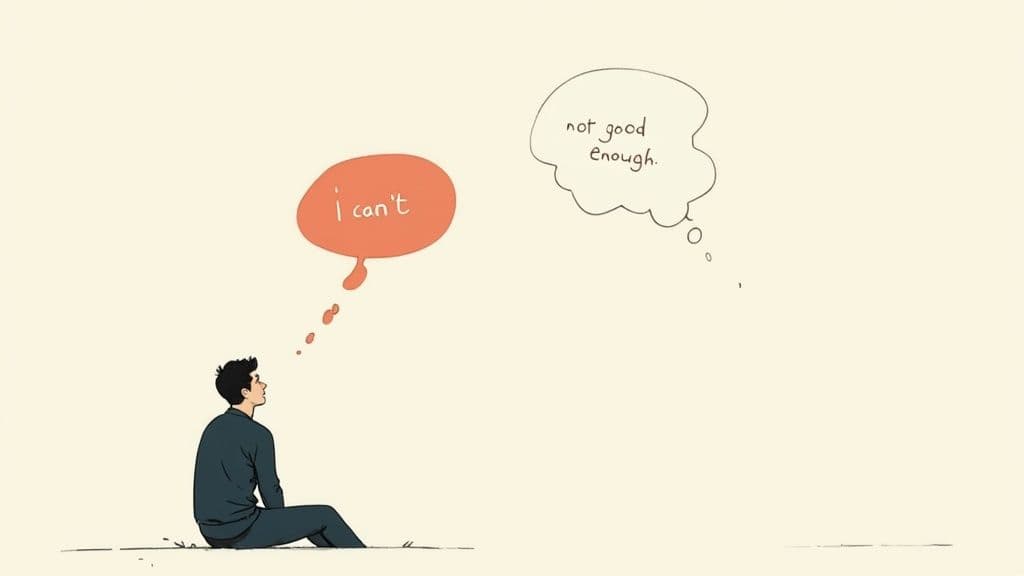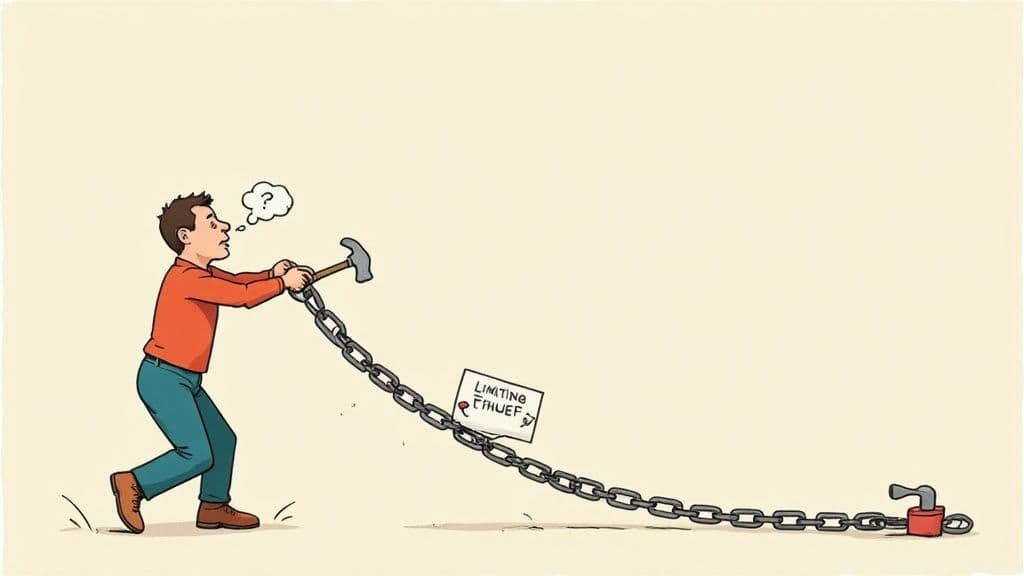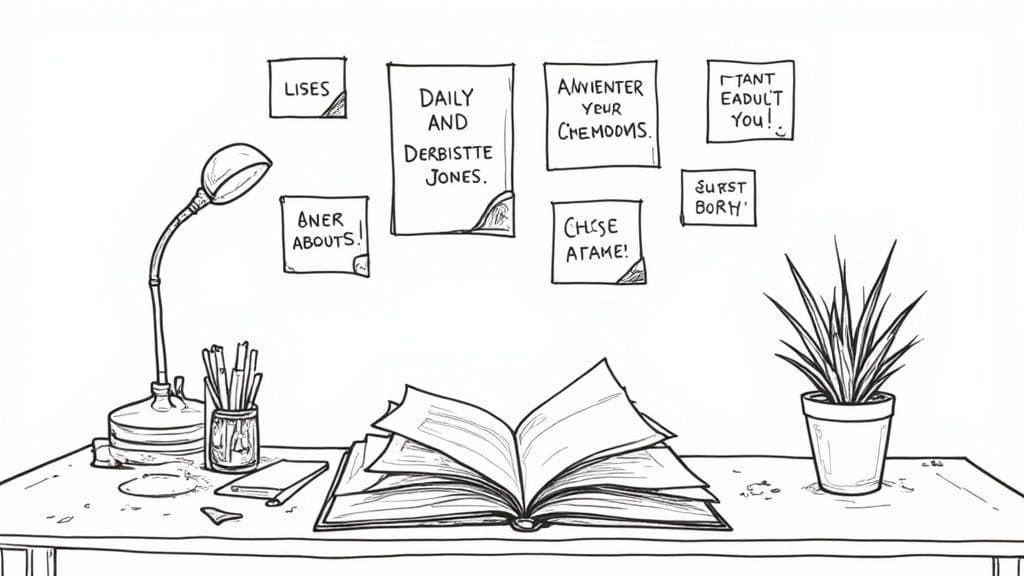Feel stuck just before reaching a goal? Limiting beliefs are often the unseen stories that block progress. This guide shows practical, evidence-based steps to identify, challenge, and rewire those beliefs so you can move forward with more confidence and purpose.
August 9, 2025 (4mo ago) — last updated October 30, 2025 (1mo ago)
Overcome Limiting Beliefs and Rewire Your Mind
Practical, evidence-based steps to identify, challenge, and rewire limiting beliefs so you can build confidence, pursue goals, and change habits.
← Back to blog
Title: How to Overcome Limiting Beliefs and Change Your Life
Summary: Learn how to overcome limiting beliefs with our guide. Discover actionable steps to identify, challenge, and rewire the thoughts holding you back.
Introduction: Learn how to overcome limiting beliefs with our guide. Discover actionable steps to identify, challenge, and rewire the thoughts holding you back.
Tags: how to overcome limiting beliefs, mindset shift, personal development, cognitive reframing, self-sabotage
Ever felt like you’re pushing against an invisible barrier, one that stops you right before you reach for something you really want? That’s the power of a limiting belief. They’re the silent, subconscious rules we live by, quietly dictating what we think is possible for us.
The Invisible Walls Holding You Back

These deep-seated beliefs are rarely grounded in objective truth. Instead, they’re stories we’ve created based on our past. A single business that didn’t take off can easily become the deeply ingrained belief, “I’m just not cut out for entrepreneurship.”
That one story, born from one experience, suddenly becomes an invisible wall. It stops you from spotting new opportunities, from trusting your instincts, and from ever trying again. You end up stuck, not because of your actual abilities, but because of a narrative you accepted as fact.
Where Do These Beliefs Even Come From?
Understanding how these mental walls get built is the first step to tearing them down. In many ways, they’re a defense mechanism. Our brains try to protect us from future disappointment by creating rules based on past pain. But this safety comes at a huge cost—it keeps us trapped in a comfort zone that’s far too small for our true potential.
Your most stubborn limiting beliefs often sprout from a few common sources:
- Past stumbles. One rejection or a single mistake gets blown up into an absolute statement about who you are and what you’re capable of.
- Someone else’s opinion. A casual remark from a parent, a teacher, or a friend years ago can get internalized and treated as gospel.
- The comparison trap. Watching others succeed can trick our minds into concluding that success is reserved for them, not for people like us.
“The problem isn’t the event that happened; it’s the meaning you gave it. The belief is the story you told yourself afterward. If you can change the story, you can change your entire reality.”
Learning how to overcome limiting beliefs is really about becoming a detective of your own thoughts. It’s about putting those old, tired stories on trial and realizing they aren’t unshakeable laws of the universe. They’re just stories. And stories can be rewritten.
A Clear Path to Rewriting Your Story
Breaking free isn’t about vague positive thinking. It’s a deliberate, structured process. You have to shine a light on the specific belief, poke holes in it with real-world evidence, and then consciously install a new, more empowering belief in its place.
That’s what this guide is all about. I’ll walk you through exactly how to do this, step-by-step. We’re going to dismantle those invisible walls, brick by brick, so you can finally step into a life that feels authentic, free, and full of purpose.
How to Uncover Your Core Limiting Beliefs
Pinpointing the exact beliefs holding you back can feel like trying to catch smoke. They’re masters of disguise, operating just beneath your conscious awareness. To bring them out into the open, you need to become a detective of your own mind.
Start by looking at the parts of your life that just feel… stuck. Where do you repeatedly hit a wall, feel frustrated, or find yourself falling short of what you want? These sore spots are almost always clues, pointing directly to a limiting belief that’s running the show behind the scenes.
Listen to Your Language
Your inner dialogue is a treasure trove of evidence. The real giveaway is often the language you use when thinking about your struggles. Keep an ear out for those rigid, all-or-nothing words that leave no room for nuance.
These words are red flags. They slam the door on possibility and frame your belief as a cold, hard fact.
They often sound like:
- “I always mess things up when it counts.”
- “I could never speak in front of a crowd.”
- “I’m too old to go back to school now.”
- “I’m just not smart enough to understand investing.”
When you catch yourself thinking in these absolutes, stop. Grab a notebook or open a notes app and write the full sentence down. Just getting the thought out of your head and onto a page helps you see it for what it is—a thought, not a truth. This is a powerful first step in learning how to develop self-awareness: https://lifepurposeapp.com/blog/how-to-develop-self-awareness
Connect Challenges to Hidden Beliefs
Once you’ve started noticing your language, the next step is to trace your recurring challenges back to their source. A general feeling of anxiety is hard to tackle, but a specific belief is something you can actually work on. Think of it like a doctor moving from a patient’s symptoms to a clear diagnosis.
For instance, let’s say someone consistently avoids applying for better jobs, even though they’re unhappy at work. The avoidance is the symptom. What’s the underlying belief fueling that behavior? It might be, “I’m not actually qualified for a senior role,” or maybe, “If I get the job, they’ll eventually find out I’m a fraud.”
“Key insight: Your actions (and your inactions) are just the surface-level symptoms. The real issue is the limiting belief causing them. You can’t solve the problem until you know what it is.”
The table below can help you start connecting the dots between your own challenges and the beliefs that might be hiding underneath.
Connecting Your Challenges to Hidden Beliefs
Use this table to connect a common challenge you’re facing to the potential limiting belief that’s driving it.
| Common Challenge or Fear | Potential Underlying Limiting Belief |
|---|---|
| Avoiding social gatherings or networking | “I’m awkward and have nothing interesting to say.” |
| Procrastinating on launching a project | “If I put my work out there, people will judge it.” |
| Hesitating to invest money or ask for a raise | “I’m bad with money and will probably lose it.” |
| Staying in a job or relationship you’ve outgrown | “I don’t deserve better,” or “This is as good as it gets.” |
By using this kind of structured approach, you shift from feeling vaguely stuck to having a clear target.
When you can finally name the belief, you strip it of its invisible power. You’ve dragged it out into the light, giving yourself a concrete starting point for rewriting your own story.
The Science of Rewiring Your Mindset

If you’ve ever felt stuck with a certain mindset, you’re not alone. But changing your core beliefs isn’t just wishful thinking. It’s a biological process rooted in the science of neuroplasticity—your brain’s capacity to adapt and rewire itself over time1.
I like to think of the brain as a dense forest. Your thoughts are the paths that run through it. A limiting belief, like “I’m not good with money,” is a path you’ve walked countless times. It’s wide, clear, and your brain follows it automatically because it’s the most efficient route.
This is exactly why just telling yourself to “be more positive” rarely sticks. You’re essentially standing at the head of that well-worn trail and trying to force yourself into an overgrown patch of wilderness. It’s no wonder we default back to what we know. The good news? You can forge a new trail—and research shows deliberate mental practice changes the brain’s structure and function over weeks to months2.
Forging New Pathways in Your Brain
Every time you consciously challenge a limiting belief and choose a new, empowering thought, you’re taking the first step in clearing a new path. It’s tough going at first. The new trail is faint and you have to deliberately push through the weeds.
Practices like focused attention, journaling, and visualization act like mental tools you use to clear and widen that new path. The more you practice a new belief, the more your brain reinforces its corresponding neural pathway.
“Overcoming a limiting belief isn’t about destroying the old path; it’s about building a new one that’s so compelling and well-maintained that your brain naturally prefers to take it.”
Eventually, this new pathway becomes the go-to route. The old, negative thought pattern doesn’t vanish entirely, but it starts to fall into disuse. You are, quite literally, rewiring your brain’s circuitry to support the life you want to live2.
Evidence of a Malleable Mind
This isn’t just a helpful metaphor; it’s documented science. Studies of mindfulness and targeted cognitive training show measurable brain changes after consistent practice, including changes in regions tied to self-regulation and attention2.
Understanding this gives you a concrete, evidence-based reason to commit to the process. You have everything you need to learn how to overcome limiting beliefs, because lasting change isn’t just possible—it’s how your brain is built to work1.
A Practical Framework to Challenge Negative Beliefs
Once you’ve dragged a limiting belief out of the shadows, you can’t just wish it away. You need a reliable, hands-on method to dismantle it, piece by piece. The most effective approach is rooted in cognitive-behavioral techniques—practical methods shown to reduce self-limiting thoughts and improve functioning for many people3.
Think of this process as putting your belief on trial. You get to be the judge and jury, examining the evidence with clear logic instead of getting swept up in emotion. This isn’t about ignoring reality; it’s about seeing it clearly, without the distortions of fear and old programming.

What I love about this is how it frames the process as a repeatable skill, not a one-time fix. It’s a cycle of awareness, questioning, and active replacement.
Put Your Belief on Trial
Let’s walk through this with a common limiting belief: “I’ll never be financially secure.” This thought feels heavy and permanent, especially if you’ve had financial struggles.
Now, let’s put it on the stand.
Gather Evidence Against the Belief
Your mind is a pro at finding proof for this belief. It’s a well-worn neural pathway. Your job is to deliberately seek out counter-evidence, no matter how small it seems.
- Did you pay your bills this month? That’s direct evidence of financial management.
- Have you ever saved any amount of money, even just $20? That proves your capacity to save.
- Did you learn a new skill that could boost your income? That’s evidence of growth and adaptability.
Explore Alternative Viewpoints
Limiting beliefs thrive on black-and-white thinking. Break that pattern by injecting nuance and realism.
- Instead of “I’ll never be secure,” try: “I’m not as secure as I’d like to be right now, but I’m learning how to improve.”
- Recognize that past mistakes don’t predict the future; they teach lessons you can use to make better choices.
“A belief is just a thought you keep thinking. Its power comes from repetition, not from truth. By questioning it, you interrupt the pattern and starve it of the attention it needs to survive.”
Craft Your New Empowering Belief
After poking holes in the old story, consciously install a new one. Make the new belief realistic, positive, and actionable.
- Old belief: “I’ll never be financially secure.”
- New belief: “I am capable of learning and implementing strategies to build financial security over time.”
This new statement focuses on capability and process. It acknowledges that building security is a step-by-step effort and points toward practical actions, which aligns with personal development work like finding purpose and building skills: https://lifepurposeapp.com/blog/how-to-find-your-life-purpose
Studies show cognitive restructuring and related practices help many people reduce self-limiting thoughts and improve outcomes when done consistently3.
Building a Support System for Lasting Change

Let’s be honest: changing your mindset is tough. You’re working against years, maybe even decades, of old mental habits. Going it alone is not just harder; it’s an uphill climb against your own well-worn internal dialogue.
A solid support system provides crucial outside perspective and encouragement. When you voice a new, empowering belief and your people reflect it back to you, it starts to feel real. That reinforcement helps the new belief stick, and peer-based support often improves outcomes for people working on mental-health and behavior change goals4.
Finding Your People
Your support crew doesn’t need to be huge, but it does need to be genuine. Look for people who will call you on your old stories, not cosign them.
- Trusted friends or family. People who see your potential even when you don’t.
- Mastermind groups. Small, dedicated groups focused on mutual growth.
- A professional coach or therapist. Trained professionals can offer unbiased guidance and proven tools.
“Trying to overcome limiting beliefs in isolation is like trying to see the label from inside the jar. An outside perspective is essential for clarity and real progress.”
Once you’ve identified your people, learn how to ask for what you need. Be specific. Instead of “I’m trying to be more confident,” try, “My old story is that I’m not a good leader. If you hear me putting myself down, could you remind me of that time I handled the team project well?”
Group support and coaching can be powerful aids in personal growth and in sustaining new habits and beliefs4.
Making Your Growth a Shared Journey
Creating a supportive environment is a non-negotiable part of your development. It’s the external piece that helps lock in all the inner work you’re doing. Shared growth makes you more resilient when you stumble and makes wins feel bigger.
Connecting with others walking a similar path can also be transformative. For further reading on community and growth, see: https://lifepurposeapp.com/blog/how-to-grow-spiritually
Got Questions? Let’s Talk Through Them
As you start digging into this work, you’ll hit snags or have questions pop up. That’s normal—and it’s a sign you’re doing important work. Below are common hurdles and practical advice to keep your momentum.
“So, how long is this going to take?”
There’s no set timetable. The time it takes depends on how long you’ve carried the belief and how tangled it is with your sense of self.
Some people notice meaningful shifts in a few weeks with consistent practice. Deeper, childhood-formed beliefs can take months to change. The key is consistency—small, daily practices add up.
“But what if my limiting belief just feels true?”
When a belief feels like an undeniable fact, it’s usually been reinforced for years. Start by asking whether the belief is useful. If it’s costing you opportunities, hunt for one tiny piece of counter-evidence. That crack is all you need to begin breaking it apart.
“What do I do when the same old belief creeps back in?”
When it shows up, follow this short plan:
- Acknowledge it—don’t fight it.
- Observe it without judgment.
- Remind yourself of the evidence against it.
- State your new belief out loud.
Every repetition weakens the old path and strengthens the new one.
Ready to discover the specific life path you were born to live? The Life Purpose App gives you instant access to a profound system of self-knowledge based on Dan Millman’s bestselling work. Find out about your core gifts, learn how to navigate your unique life cycles, and get the clarity you’ve been searching for. Download the app and start exploring your purpose today.
Quick Q&A
Q: How do I spot a limiting belief? A: Listen for absolute language—“always,” “never,” “I can’t.” Write the thought down and trace recurring problems back to the belief driving them.
Q: What’s the simplest way to challenge a limiting belief? A: Treat it like a hypothesis. Gather counter-evidence, explore alternative explanations, and craft a realistic, actionable replacement belief.
Q: Do I need a therapist to change these beliefs? A: Not always. Many people make progress with self-directed practices and peer support. But a coach or therapist can speed progress and help with deeply rooted beliefs.
Discover Your Life Purpose Today!
Unlock your true potential and find your life’s purpose.
